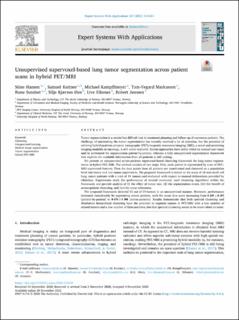| dc.contributor.author | Hansen, Stine | |
| dc.contributor.author | Kuttner, Samuel | |
| dc.contributor.author | Kampffmeyer, Michael | |
| dc.contributor.author | Markussen, Tom-Vegard | |
| dc.contributor.author | Sundset, Rune | |
| dc.contributor.author | Øen, Silje Kjærnes | |
| dc.contributor.author | Eikenes, Live | |
| dc.contributor.author | Jenssen, Robert | |
| dc.date.accessioned | 2021-02-02T13:51:34Z | |
| dc.date.available | 2021-02-02T13:51:34Z | |
| dc.date.created | 2020-12-09T09:18:12Z | |
| dc.date.issued | 2020 | |
| dc.identifier.issn | 0957-4174 | |
| dc.identifier.uri | https://hdl.handle.net/11250/2725856 | |
| dc.description.abstract | Tumor segmentation is a crucial but difficult task in treatment planning and follow-up of cancerous patients. The challenge of automating the tumor segmentation has recently received a lot of attention, but the potential of utilizing hybrid positron emission tomography (PET)/magnetic resonance imaging (MRI), a novel and promising imaging modality in oncology, is still under-explored. Recent approaches have either relied on manual user input and/or performed the segmentation patient-by-patient, whereas a fully unsupervised segmentation framework that exploits the available information from all patients is still lacking.
We present an unsupervised across-patients supervoxel-based clustering framework for lung tumor segmentation in hybrid PET/MRI. The method consists of two steps: First, each patient is represented by a set of PET/MRI supervoxel-features. Then the data points from all patients are transformed and clustered on a population level into tumor and non-tumor supervoxels. The proposed framework is tested on the scans of 18 non-small cell lung cancer patients with a total of 19 tumors and evaluated with respect to manual delineations provided by clinicians. Experiments study the performance of several commonly used clustering algorithms within the framework and provide analysis of (i) the effect of tumor size, (ii) the segmentation errors, (iii) the benefit of across-patient clustering, and (iv) the noise robustness.
The proposed framework detected 15 out of 19 tumors in an unsupervised manner. Moreover, performance increased considerably by segmenting across patients, with the mean dice score increasing from (patient-by-patient) to (across-patients). Results demonstrate that both spectral clustering and Manhattan hierarchical clustering have the potential to segment tumors in PET/MRI with a low number of missed tumors and a low number of false-positives, but that spectral clustering seems to be more robust to noise. | en_US |
| dc.language.iso | eng | en_US |
| dc.publisher | Elsevier | en_US |
| dc.rights | Navngivelse 4.0 Internasjonal | * |
| dc.rights.uri | http://creativecommons.org/licenses/by/4.0/deed.no | * |
| dc.title | Unsupervised supervoxel-based lung tumor segmentation across patient scans in hybrid PET/MRI | en_US |
| dc.type | Peer reviewed | en_US |
| dc.type | Journal article | en_US |
| dc.description.version | publishedVersion | en_US |
| dc.source.journal | Expert systems with applications | en_US |
| dc.identifier.doi | 10.1016/j.eswa.2020.114244 | |
| dc.identifier.cristin | 1857761 | |
| dc.description.localcode | /© 2020 The Author(s). Published by Elsevier Ltd. This is an open access article under the CC BY license (http://creativecommons.org/licenses/by/4.0/) | en_US |
| cristin.ispublished | true | |
| cristin.fulltext | original | |
| cristin.qualitycode | 1 | |

